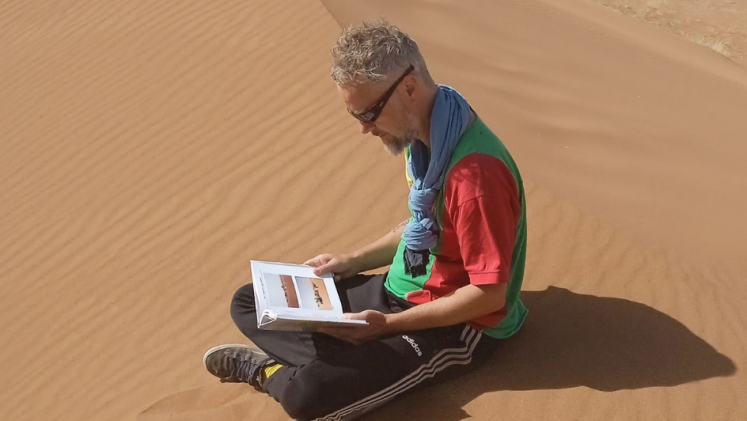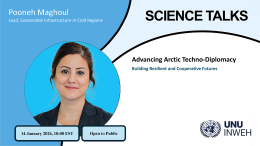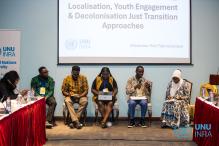Dr. Kees van der Geest is a human geographer and migration expert at UNU-EHS who leads the Environment and Migration: Interactions and Choices Section. He studies the impacts of climate change, human mobility, environmental change, adaptation, livelihood resilience and rural development. Key features of his work are the people-centred perspective and the mixed-method approach combining quantitative and qualitative research tools. Kees' work has contributed substantially to expanding the empirical evidence base on migration-environment linkages and impacts of climate change beyond adaptation (“loss and damage”). We sat down with Kees to learn more about his work.
Can you tell us about how climate change is a factor in migration and its terminology?
The relation between climate impact and human mobility is a complex one. People move for a variety of reasons and one can be climate change impacts. What is often not explicitly acknowledged is that there are different options besides migrating. If a certain region or community is faced with climate change impacts, there usually are things that can be done in terms of adaptation and improved disaster risk reduction measures. In Northern Ghana, for example, where droughts are becoming more frequent, farmers can switch to more drought-resistant crops or try to make their livelihoods less dependent on farming. Migration is just one of the options. Scientists who do not have sufficient knowledge of the local context might not always realize that. For example: an environmental scientist may conclude that the implication of one meter of sea level rise will be that all land below one meter will no longer be habitable, causing all people that live there to become climate migrants. In this case, the adaptive capacity of people is not acknowledged, which results in wild estimates of millions of displaced people.
It is also important to realize that there are different types of climate mobility, and each has a different relation to climate change. We are currently developing an e-learning course where we use the term “human mobility in the context of climate change”, which includes four categories: migration, displacement, planned relocation and trapped populations or involuntary immobility: people who would prefer to leave, but cannot due to issues such as a lack of means in terms of finance, papers or contacts. It’s important to capture this diversity of mobility types. Migration, for example, is more voluntary and can be an effective adaptation to climate change. By contrast, displacement is more forced and tends to have more negative consequences so it is something that should be avoided as much as possible.
What combined reasons would you say lead to migration – either within or across country borders?
About 15 years ago, UNU-EHS was one of the first research institutes to conduct empirical research on environmental migration. Since then, we have been doing fieldwork research in many countries. Personally, I have done fieldwork in Ghana, Viet Nam, Nepal, Bangladesh and in the Marshall Islands. Many of the places I went to can be considered the frontiers of climate change, where you could expect that climate migration is already common. However, even in such places the relation between climate impact and human mobility is complex. In each of these research areas, people were facing climate change impacts that directly affected their livelihoods. I expected that these impacts would play a central role in people’s decisions to leave. However, the reason to move was always a combination of factors. It is important to realize that migration is a normal phenomenon, it is part of the human experience. So research should look at how climate change influences migration patterns, and not think of migration as something that is created by climate change alone.
A few years ago for example, I had the opportunity to do a research project of two years in the Marshall Islands, an atoll nation in the Pacific. I expected that environmental factors would play a key role in migration motives as sea level rise threatens the habitability of these low-lying islands. We already knew that within the last thirty years a third of the population had left the Marshall Islands to go live in the USA, for which the Marshallese do not need a visa. Surprisingly, after conducting our research, the conclusion we had to draw was that the respondents to our survey barely listed climate change impacts as a migration motive. Reasons that were mentioned related primarily to education, work, health care and family reunion. This does not necessarily mean that climate change does not play a role at all. We also did a spatial analysis that looked at migration rates and the actual impacts of climate change on households. Here we did find significant correlations: people who had experienced more severe impacts of climate change had higher migration rates. This shows the complexities of doing this type of research. Different ways of approaching the question may result in different insights. That is why it is important to do mixed-method research.
Another interesting finding was that though migrants mostly said that climate change was not among their main reasons for moving to the US, they did indicate that it was a reason for them to reconsider moving back to the Marshall Islands someday. This could be related to the education level and the exposure to media being higher once living in the US, causing migrants to be more aware of the dangers of climate change.
With our work we attempt to bring nuance in the debate between statements that climate change will cause hundreds of millions of climate migrants on the one hand, and climate change not playing a role in migration motives at all on the other.



